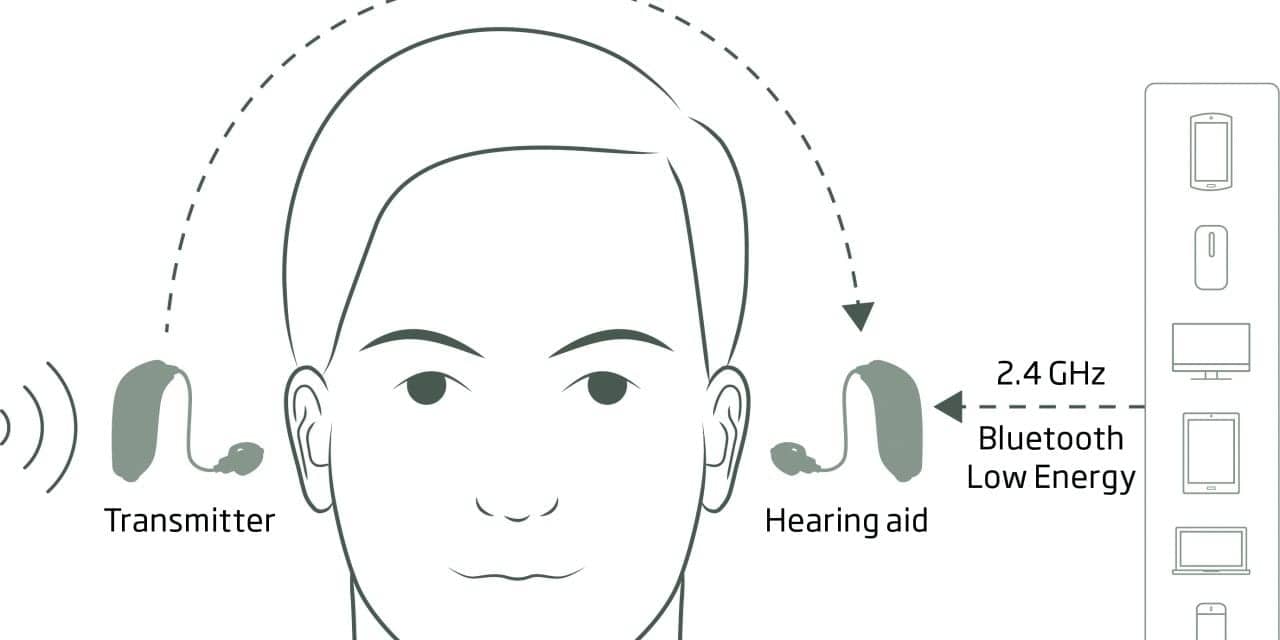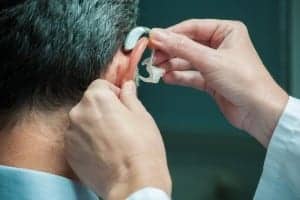SPECIAL ISSUE: Unilateral Hearing Loss | Tech Topic | October 2019 Hearing Review
A CROS solution is often recommended for persons with single-sided deafness (SSD) or unaidable hearing in one ear. Oticon CROS is the first wireless CROS/BiCROS solution with dual-streaming capability using an open sound paradigm. As shown in this study, the dual-streaming capability, with the receiving hearing aid of the CROS solution simultaneously receiving sound inputs from both the transmitting hearing aid and an external source, provides considerable benefit.
Approximately 60,000 new cases of SSD arise in the United States each year.1 The consequences of SSD vary significantly across individuals. However, people with SSD often struggle with listening in noisy environments and their ability to localize sounds is often significantly compromised.2 Further, they struggle with impaired speech understanding, reduced spatial awareness, and they may experience a reduced ability to selectively attend to a specific sound.3 These factors cause difficulties when trying to identify the direction of unexpected sounds, including incorrectly presuming that all sound sources are located on the better ear side.
The functional hearing difficulties associated with SSD may also affect social and psychological well-being. Test subjects of the Lucas, Katiri, and Kitterick study3 reported embarrassment related to social stigma, and reduced confidence and belief in their ability to participate in communication, which resulted in activity limitations and participation restrictions including withdrawal from situations. A recent review by Galloway et al4 also support these conclusions.
A New Dual-Streaming CROS/BiCROS
The Oticon CROS solution consists of a transmitter placed on the poorer ear, which sends a signal to the receiving and compatible Oticon hearing aid located on the better ear via near-field magnetic induction (NFMI). Figure 1 shows two scenarios: the better ear can be either normal hearing (CROS fitting) or hearing impaired (BiCROS fitting). The CROS transmitter is a miniRITE T style hearing aid with the necessary functionality to perform advanced signal processing similar to the Oticon Opn S hearing aid. Within the noise suppression algorithm, OpenSound Navigator (OSN) has four help levels (Low, Medium, High, and Very High) and a varying degree of available noise reduction for simple and complex acoustic environments.
The new device differs from a conventional Opn S hearing aid in that the OSN noise handling is customized for this specific user group, due to their unique needs. OSN in Oticon CROS is implemented with a fixed 0 dB noise reduction setting for simple environments and a -5 dB noise reduction setting for complex environments. The transition setting is High, meaning that the -5 dB noise reduction is provided for users even in less noisy environments. It is of maximal importance that the CROS/BiCROS users have access to noise reduction on their poorer ear side, while simultaneously maintaining access to environmental sounds and thus allowing the best conditions for speech awareness on the poorer ear side.
Speech Awareness Study
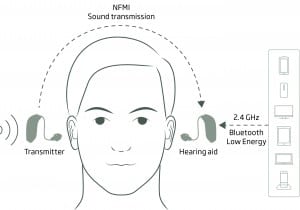
Figure 1. Oticon CROS/BiCROS offers dual-streaming technology with the hearing aid capable of receiving sound input from the transmitting hearing aid and external and environmental sources simultaneously while also having access to noise reduction on the poorer rear.
The primary goal of the Oticon CROS solution is that users should experience improved audibility, improved environmental awareness, and better speech understanding for sounds which originate on the side of their poorer ear. The current study assessed one of these aspects, namely whether test subjects experienced greater speech awareness of environmental sounds while simultaneously streaming from an external source.
The external source used here was the Oticon ConnectClip, which transmitted sound to the receiving hearing aid via 2.4 GHz Bluetooth® low-energy technology. Previously, there has not been a solution on the market that has been technically able to continue ear-to-ear audio streaming while streaming from other sources. The purpose of this study was to evaluate whether there would be audiological benefit to the user in this situation (Figure 1). In the study, the outcome measure was speech awareness of target words that were presented to the test subjects’ poorer ear side during streaming from the ConnectClip. It was hypothesized that test subjects would be significantly more aware of the target words when the transmission of sound from the CROS transmitter was ON versus OFF.
Test subjects. The test subjects were 8 people with SSD, half of whom were CROS candidates, and the other half were BiCROS candidates. The subjects’ average age was 59 years old (range: 18 to 80 years). Five test subjects had never previously worn a hearing aid or a CROS system, while 3 wore competitor CROS solutions. All test subjects had been appropriately and optimally fitted with the Oticon CROS solution prior to the lab test.
Methods. The two test conditions in the study were either CROS transmission ON or OFF. In the lab setup, the test subjects were given two simultaneous listening tasks but were trained in performing the first task prior to the introduction of the second task (Figure 2).
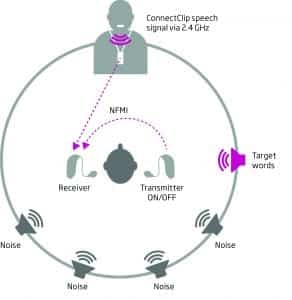
Figure 2. The test setup consisted of ICRA speech-like noise from four speakers behind the listener in two conditions: 1-minute news segments presented using a ConnectClip remote microphone, and target words from the poor-ear side of the listener.
The first task was to listen to 1-minute news segments about a variety of unknown topics. These news segments were streamed via the ConnectClip to the receiving hearing aid, and the test subjects were instructed to pay attention to these. The ConnectClip was placed in front of the test subjects on a Brüel & Kjær Head And Torso Simulator (HATS) with the microphone within 20 cm of the HATS’s mouth, and the news segments were played from the mouth of the HATS. After each 1-minute news segment, the test subjects were given a listening comprehension task and were prompted to answer a question about the segment on a tablet.
The news segments were created at Eriksholm Research Center in Denmark and consisted of 26 clear speech stimuli. The presentation signal was adjusted to a comfortable listening level for each test subject, since it was important that the test subjects heard it easily and clearly.
The second task, also the outcome measure, was to detect common 2-syllable Danish target words, presented from a loudspeaker on the transmitter side. When the test subject became aware of a word, he/she would push a button as a response. The target words were specifically created for this study and consisted of 208 short, common Danish words and phrasal verbs, like “se her” (“look here” in English) adopted from Danish news feeds. The words were presented with randomized breaks of 2, 4, 6, and 8 seconds, and there were 8 words presented in each 1-minute test segment. The lengths of the breaks were randomized to prevent predictable time intervals and thus predictable responses from the test subjects. A response from the test subject was scored as correct if it was present within 2 seconds of the target word presentation.
Noise from the International Collegium of Rehabilitative Audiology (ICRA) was presented at a fixed level of 67 dB SPL throughout the test from a four-loudspeaker array behind the test subjects (see Figure 2). The purpose of the noise was to create a realistic real-world situation where a CROS/BiCROS candidate might choose to use an assistive listening device to help them hear better.
The test started with a training block, followed by two blocks corresponding to the two conditions. In addition to familiarizing the test subjects with their tasks, the training block was used to find each individual test subject’s target word presentation level (ie, the level at which the test subject was aware of and responded to approximately 2 out of 8 possible target words with the transmitter OFF). This was to avoid a possible ceiling effect when the transmitter was turned ON. The level of the target words started at 65 dB SPL, and the test leader raised or lowered the level for the signal depending on the test subject’s responses until the correct level was reached. The two test blocks consisted of 13 one-minute segments, with one news segment and 8 target words within each segment.
The two conditions were randomized across test subjects; however, the segments and target words were not. Thus, each test participant was subjected to a total of 26 segments, corresponding to 104 data points per condition.
Results

Figure 3. Results of speech awareness ability when the transmission of sound was turned ON compared to when it was turned OFF, demonstrating the benefit of having dual-streaming capability within a CROS hearing aid solution (*p = 0.0025).
This study showed a statistically significant difference in speech awareness ability for test subjects when the transmission of sound was turned OFF (2.6 out of 8 words, or 33%) versus ON (3.9 out of 8 words, or 49%) while streaming from an external source. This meant that the test subjects pressed the button because they detected target words on their poorer side 50% more often when the transmission was ON versus OFF. Figure 3 shows the average improvement for each 1-minute segment for the ON versus OFF conditions.
The results support the benefit of having dual-streaming capability within a CROS solution and facilitates a distinct real-world advantage. An apt comparison is when users of hearing aids with telecoils want the option of being able to keep their hearing aid microphones on while receiving sound through a looped sound source. Telecoil users engage this to be able to carry on a conversation with someone sitting next to them while at the theatre or watching a film at home.
People with SSD have similar needs while streaming. They do not want to lose environmental awareness—such as traffic, public situations, and children needing attention—while simultaneously being aware of, and attentive to, someone speaking to them from their poorer ear side.
Conclusion
Oticon CROS brings the proven benefits (better speech understanding, less listening effort, and improved memory recall) of the advanced signal processing of OpenSound Navigator to people with SSD. Furthermore, TwinLink dual-streaming provides users with improved environmental awareness and speech awareness while streaming. This study showed a 50% improvement in speech awareness in a dual-streaming scenario, indicating a clear and substantial audiologic benefit related to having improved access to environmental sounds.
References
-
Williams VA, McArdle RA, Chisolm TH. Subjective and objective outcomes from new BiCROS technology in a veteran sample. J Am Acad Audiol. 2012;23(10)[Nov-Dec]:789-806. doi: 10.3766/jaaa.23.10.5.
-
Olsen SØ, Hernvig LH, Nielsen LH. Self-reported hearing performance among subjects with unilateral sensorineural hearing loss. Audiological Medicine. 2012;10:83-92.
-
Lucas L, Katiri R, Kitterick PT. The psychological and social consequences of single-sided deafness in adulthood. Int J Audiol. 2018;57:1, 21-30, DOI: 10.1080/14992027.2017.1398420
-
Galloway J, Zhang V, Marnane V, Hou S, Stewart G, Bardy F. The impact of unilateral hearing loss on adult life. Hearing Review. 2019;26(4)[Apr]:10-14. Available at: https://hearingreview.com/2019/03/impact-unilateral-hearing-loss-adult-life/
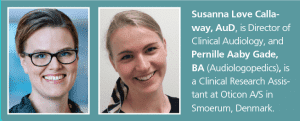
, is Director of Clinical Audiology, and Pernille Aaby Gade, BA (Audiologopedics), is a Clinical Research Assistant at Oticon A/S in Smoerum, Denmark.
CORRESPONDENCE can be addressed to Dr Callaway at: [email protected]
Citation for this article: Callaway SL, Gade PA. A new dual-streaming CROS/BiCROS solution. Hearing Review. 2019;26(10)[Oct]:22-23.
Other articles in the October 2019 Hearing Review special edition on unilateral hearing loss:
- Introduction to Special Edition: Unilateral Hearing Loss: Underappreciated, Undertreated, By Karl Strom
- Contralateral Routing of Signal: A Status Report 2019, By Douglas L. Beck, AuD, and Virginia Ramachandran, AuD, PhD
- Unilateral Hearing Loss in Children: Current Perspectives, By Anne Marie Tharpe, PhD
- A New Dual-Streaming CROS/BiCROS Solution, By Susanna Løve Callaway, AuD, and Pernille Aaby Gade
- Managing People with Sensorineural and Conductive Unilateral Hearing Loss and Single-Sided Deafness, By Amanda O’Donnell, AuD, and Allison Racey, AuD
Also see:
- The Impact of Unilateral Hearing Loss on Adult Life, By James Galloway, MSc; Vicky Zhang, PhD; Vivienne Marnane; Sanna Hou, MClinAud; Greg Stewart, and Fabrice Bardy, PhD

